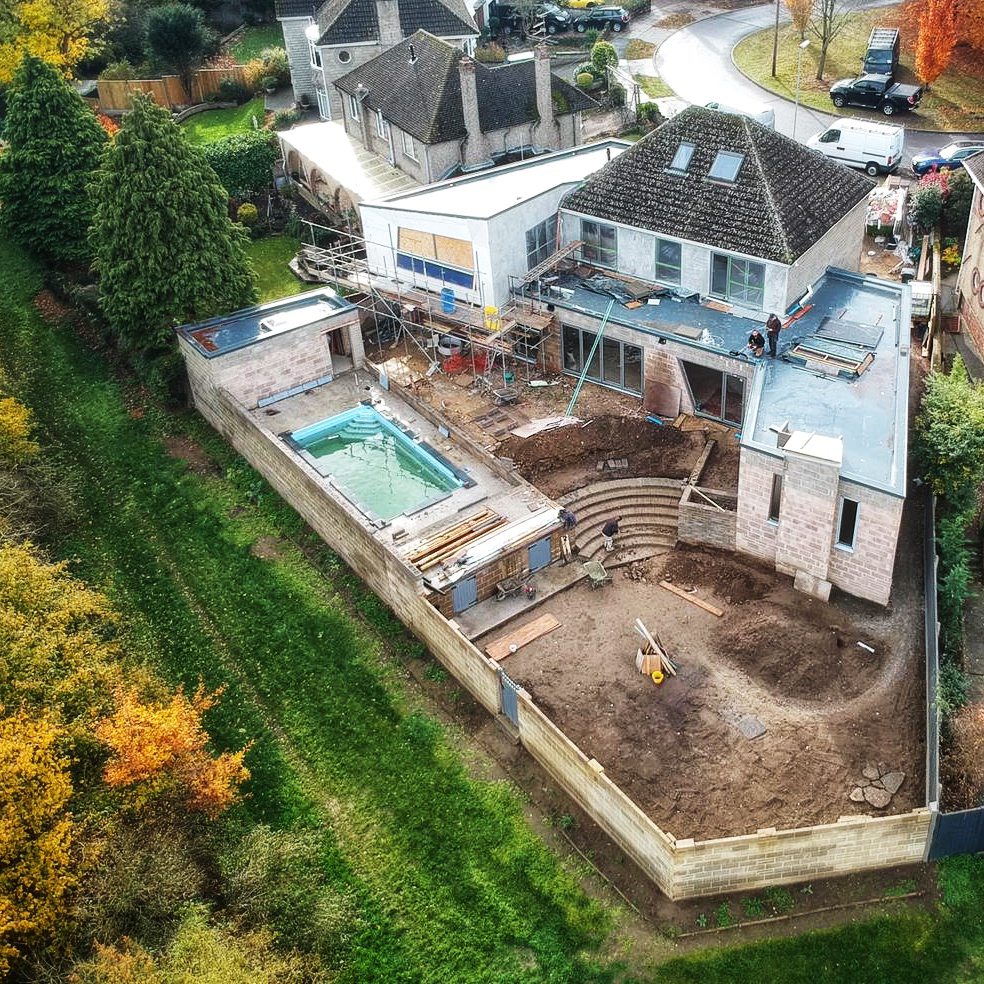What is the best type of construction for a swimming pool? In this article, we are going to detail and compare different types of swimming pool construction. There are several different ways to build a swimming pool in your garden including reinforced concrete, masonry block, vinyl liner, and prefabricated fiberglass. You can also choose between an above-ground, an infinity or overflow pool, or a skimmer (where the water level is below that of the pool edge). SWJ Consulting has designed many reinforced concrete swimming pools for clients throughout the UK. We feel this is the best and most enduring type of swimming pool construction so don’t design any other.
It is not just the swimming pool itself that needs to be designed but the plant (machinery) housing, that enables the pool to run, and the drainage for when the pool needs to be emptied. When you are considering if you can build a swimming pool in your garden there are several factors to take into account – feasibility, construction methods, and budget. We cover feasibility in a separate article, and it might be a good idea to read that one too, to help inform your decisions.
In this blog we will give you a quick rundown of three different types of swimming pool construction methods, commonly used in the UK, so you can understand the differences.
Reinforced Concrete Swimming Pools
There are several advantages to concrete swimming pools, apart from durability, you also have flexibility in the design. You can pretty much have any design you like with concrete but with a fiberglass prefabricated shell, you must choose from the available designs. This also restricts any additional elements you might like included such as steps and ledges, water features, and seating areas. If your garden or property is an unusual shape, on a slope, or has a corner to work around then the flexibility and customisation of a concrete pool is best. You can also choose from a range of finishes with concrete pools tiles, stone, glass, marble, quartz, plaster, and more. With Fibreglass and liner, your options are limited.
This type of construction involves excavating the ground and then creating a concrete ‘shell’ that is reinforced with steel rods and is shuttered and then concrete placed, sprayed concrete can also be applied to a pre-assembled steel reinforcement frame.
When close to residential buildings (and in all commercial pools) the concrete shell of the pool is designed to be water-tight before any internal rendering is applied. It is considered a monolithic structure, an object in its own right, and should be able to hold the volume of water whether in or out of the ground. This just gives you an insight into the strength and durability of a reinforced concrete swimming pool.
Points about reinforced concrete pools:
- You are not limited to prefabricated shapes and designs
- Using blockwork may also limit the shape of your pool
- You will need to consider where holes for access for lights and filters are needed within the pool – but your pool designer and your structural engineer can help you with this
- Concrete pools take longer to install and complete (up to three months)
A concrete pool may be more expensive initially but provided you maintain it (as you have to do with any pool) it should last 50 years+
Masonry Swimming Pools
Masonry concrete block walls that are tied to a poured concrete floor are a common way to build pool walls in private and smaller commercial pools. These are cavity walls with poured concrete in between the blocks. Blockwork is quicker and cheaper to construct but it can limit the shape of the pool.
Liner Pools
A liner pool also needs excavation, but the ‘structure’ of a liner pool is not reinforced and is not watertight. This is to allow movement in the groundwater pressure and the flexibility of the liner means your pool won’t collapse as the ground naturally moves. Any structure for the liner is simply there to give the pool shape and keep the liner in place. The structure is commonly made from composite “plastic” wall panels held in place by vertical frames set in concrete. Generally speaking, liner pools have a constant depth of 1m and then the pool can be graded to provide a slope or steps. Liner pools again have limitations in shape because of the construction of the walls and the liner shapes and sizes available.
Liner pools are probably your cheapest and quickest option for building a swimming pool, but they have a limited lifespan of 6-12 years and the liner is easily torn so you may need to replace it in that time.
Points about liner pools:
- You are limited in the shapes and designs of your pool as well as the finish
- You will need to consider whether the users of the pool (children, pets) are likely to tear a hole in the liner
- A liner pool is probably your cheapest and quickest option
- A liner pool is not expected to last more than about 12 years – with the chance you’ll need to change the liner during this time.
Fibreglass prefabricated pools
Fibreglass pools are a single-piece shell that is prefabricated and delivered to fit in a prepared excavation, usually with a concrete base. Plumbing connections are then made to the plant room and then the whole area is back-filled ready to add the finishing touches.
The main advantage is the drastic reduction in installation time, typically days rather than weeks or months– as with a concrete pool and less factors can cause delays such as bad weather. Fibreglass pools are also usually pre-plumbed and pressure tested so this work doesn’t have to happen on-site.
The finish of a fiberglass pool is maintenance-free over the lifetime of the pool, whereas a liner pool will require relining and a concrete pool may require retiling, replastering, or repainting every 10 to 15 years.
Points about fiberglass pools:
- You are limited in the shape and design of your pool as well as the finish
- You will need to consider whether you have adequate access for the fiberglass shell to be delivered
- A fiberglass pool has a life expectancy of around 15-20 years before it needs repairing but generally needs less maintenance than liner or concrete
We hope this has given you some insight into the types of swimming pools you can opt for. As already stated, SWJ Consulting only designs for reinforced concrete swimming pools – and so if that is your preferred option then please do give us a call on 01993 225 085 or email mail@swjconsulting.co.uk.




